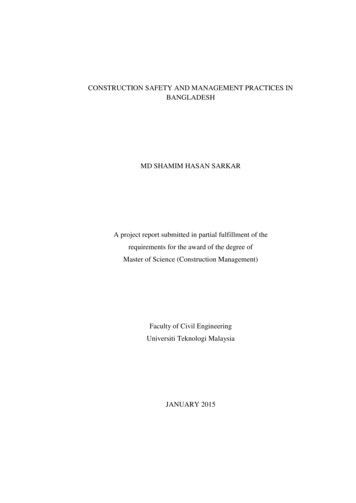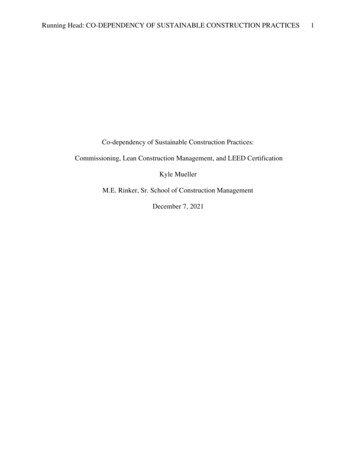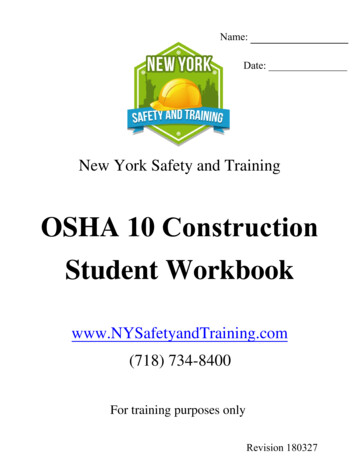
Transcription
CONSTRUCTION SAFETY AND MANAGEMENT PRACTICES INBANGLADESHMD SHAMIM HASAN SARKARA project report submitted in partial fulfillment of therequirements for the award of the degree ofMaster of Science (Construction Management)Faculty of Civil EngineeringUniversiti Teknologi MalaysiaJANUARY 2015
iiiThis project report is dedicated to my parents, my wife and my family fortheir endless support and encouragement.
ivACKNOWLEDGEMENTFirst and foremost, I praise Allah, The Almighty, on whom ultimatelywe depend on for sustenance and guidance. I would like to express my heartfeltgratitude to my supervisor Associate Professor Dr. A.S.M. Abdul Awal for hisconstant support during my study at UTM. He inspired me greatly to work in thisproject. His willingness to motivate me contributed tremendously towardscompletion of the project. I have learnt a lot from him and I am fortunate to have himas my mentor and supervisor.I would like to thank the authority of Universiti Teknologi Malaysia (UTM)for providing me with a good environment and facilities to complete this project. Iwould also like to thank the Occupational Safety, Health and EnvironmentFoundation (OSHE) of Bangladesh for providing me information and research data.Last but not the least, my profound appreciation goes to my parents and mywife for their prayers, patience, love, motivation and encouragement.
vABSTRACTBangladesh is experiencing a building construction boom. At present thereis a culture of high rise buildings, foot over bridge, building construction and repairof roads, placing of utility services etc. and it seems that the city is in buildingconstruction frenzy although it indicates the continuous development of the country.Unfortunately, it is done in a very careless and unprofessional manner without thesafety practices. The aim of this study is to present the safety issues in constructionpractices and it focuses on the existing safety scenario in the construction sites. Themain objective of this study is to collect the accident data to study and analyse thesafety issues of construction practices. The study is carried out by questionnairesand interviews. A total of 150 questionnaires was distributed to 30 constructionsites of Dhaka city in Bangladesh. The respondents were site engineers, projectmanagers, contractors and workers/ labours. The collected data is analysed usingthe frequency analysis. From the study it was found that, safety equipment, ingeneral, are not adequate both in terms of quantity and quality in construction site.Considering manpower, most of the workers are not trained about safety andmanagement practices in construction site. Along with the general observations, acase study of ‘Rana Plaza’ disaster is also highlighted in this project.
viABSTRAKBangladesh sedang mengalami ledakan pembinaan bangunan yang pesat.Pelbagai jenis pembinaan yang dijalan kan seperti bangunan pencakar langit,perumahan, perindustrian, jejantas dan kerja-kerja pembaikan jalan raya. Inimenunjukkan bahawa sector pembinaan akan menjadi sector yang terpenting lankantanpamengambilberat dasar-dasar keselamatan dan tidak professional.Tujuan kajian inidijalankan adalah untuk membentangkan isu-isu keselamatan dalam kerja-kerjapembinaa dan senario keselamatan sebenar ditapak pembinaan diberikan tumpuan.Objektif utama kajian ini adalah untuk mengumpul data kemalangan untukmengkaji dan menganalisis isu-isu keselamatan amalan pembinaan. Kajian inidijalankan dengan soal selidik dan sesi temubual. Sebanyak 150 set soal selidiktelah diedarkan kepada 30 tapak pembinaan di bandar Dhaka, Bangladesh.Responden adalah jurutera tapak, pengurus projek, kontraktor dan pekerja / buruh.Data yang dikumpul dianalisis dengan menggunakan analisis kekerapan. Dari kajianini didapati bahawa, peralatan keselamatan secara umumnya tidak mencukupi darisegi kuantiti dan kualiti di tapak pembinaan. Memandangkan tenaga kerja,kebanyakan pekerja tidak terlatih mengenai amalan keselamatan dan pengurusan ditapak pembinaan. Bersama-sama dengan ini pemerhatian umum kajian kes bencana'Rana Plaza' juga diketengahkan dalam projek ini.
viiTABLE OF MENTivABSTRACTvABSTRAKviTABLE OF CONTENTSviiLIST OF TABLESxiiLIST OF FIGURESxvLIST OF ABBREVIATIONSxviiiLIST OF APPENDICESxixINTRODUCTION11.1General11.2Problem statement21.3Aim and Objectives31.4Scope of Study31.5Structure of the dissertation4LITERATURE REVIEW62.1Introduction62.2Concept of safety culture72.3Implementation of safety culture inconstruction sector82.3.1 Planning8
viii2.3.2 Responsibilities for safety measures92.3.3 Preconstruction phase92.3.4 Construction phase102.3.4.1 Organizational structure102.3.4.2 Site layout102.3.4.3 Construction strategy andconstruction sequence2.3.4.4 Construction control12122.3.4.5 Professional services andresponsibilities122.3.5 Construction management132.3.5.1 Time management132.3.5.2 Quality management132.3.5.3 Cost management142.3.5.4 Protection of public andworkers2.3.6 Socio-economic impact14152.3.7 Overview of construction industry inBangladesh2.42.517Overview of construction safety inBangladesh212.4.1 OSHE23Overview of construction industry across theglobe252.5.1 Contribution of construction sector tonational economy (GDP)2.62.7Analysis of fatality ratesImportance of construction safety fordeveloping countries2729322.8Health and safety legislation342.9Concluding remarks39
ix34RESEARCH METHODOLOGY403.1Introduction403.2Study area403.3Target population423.4Study limitations423.5Methodology flow chart433.6Research stages443.6.1 First stage- Preliminary study443.6.2 Second stage- Primary data443.6.3 Third stage- Secondary data453.7Data analyzing463.8Frequency analysis463.9Concluding remarks47DATA ANALYSIS AND RESULTS484.1Introduction484.2Primary data analysis494.2.1 Managerial status with regard to safetyinspection in construction site494.2.2 Use of personal protective equipment’s(PPE) in construction site4.2.350First aid provision and facilities inconstruction site534.2.4 Training and regular safety practices inconstruction site4.2.5 Safety measures in construction site54554.2.6 Types of fatalities based upon thenature of accidents in construction site584.2.7 Gender ratio of victims of constructionaccidents594.2.8 Report tendency after fatal accidents in4.3construction site60Secondary data analysis61
x4.3.1 Year wise distribution of number offatalities614.3.2 District wise distribution of fatalities inBangladesh624.3.3 Ratio of buildings constructed perfatality654.3.4 Distribution of fatalities based uponnature of accident674.3.5 Analysis of different causes of4.45accidents694.3.5.1 Fall from heights694.3.5.2 Electrocuted724.3.5.3 Fall of material744.3.5.4 Roof collapse754.3.5.5 Wall collapse764.3.5.6 Earth collapse774.3.5.7 Suffocation774.3.5.8 Accident during piling work794.3.6 Month wise distribution of fatalities804.3.7 Time wise distribution of fatalities824.3.8 Age wise distribution of fatalities834.3.9 Gender ratio85Concluding Remarks86CONCLUSIONS AND .2.1 Objective one: investigation of thesafety related issues of building88construction sites5.2.2 Objective two: evaluation of usingPersonal Protective Equipment (PPE)89
xiby the workers and accidents occur inconstruction site5.2.3 Objective three: overview the accidentshave occurred in construction of89Bangladesh5.3Recommendations895.3.1 Recommendation to the BangladeshGovernment5.4895.3.2 Recommendations to developers905.3.3 Recommendations for workers91Scope for future study91REFERENCES92Appendices A-C97–132
xiiLIST OF TABLESTABLE NO.TITLEPAGE2.1Employment by major industry in Bangladesh182.2Gross domestic product of Bangladesh at current19prices, 2008-09 to 2012-13.2.3Sector wise distribution of fatalities in different21workplaces in Bangladesh2.4Injury & death statistics in construction sector in25Bangladesh2.5Contribution of construction sector to national GDP28(Gross Domestic Product)2.6Country wise fatality rate in construction sector (312.7Laws governing OSH in construction industry in35different countries4.1Managerial status with regard to safety inspection494.2Use of personal protective equipment’s (PPE) in50construction site4.3Types of safety equipment’s used in construction sites514.4No. of available sets of safety equipment’s used in52construction sites4.5First aid provision and facilities in construction site534.6Steps considered after the accident occurs to anyone54in construction site4.7Training and regular safety practices in constructionsite55
xiii4.8Safety measures in construction site564.9Type of safety measures in construction site574.10Distribution of different causes of fatalities in58construction site4.11Gender ratio of victims in construction site594.12Report to the police/media about the fatalities in60construction site4.13District wise distribution of fatalities in Bangladesh624.14Ratio of building constructed per fatality (2009-2012)664.15Distribution of fatalities based upon nature of accident684.16Distribution of fatalities based upon different causes71of falls4.17Distribution of fatalities based upon nature of73electrocuted4.18Distribution of fatalities based upon nature of fall of74material4.19Distribution of fatalities based upon nature of roof75collapse4.20Distribution of fatalities based upon nature of wall76collapse4.21Distribution of fatalities based upon nature of earth77collapse4.22Distribution of fatalities due to suffocation in78underground water tank/septic tank4.23Distribution of fatalities based upon nature of accident79during piling work4.24Month wise distribution of fatalities804.25Time wise distribution of fatalities824.26Age wise distribution of fatalities844.27Gender ratio of fatalities85C.1Information of Rana Plaza116C.2Rana Plaza foundation type information118C.3Occupancy of the building Rana Plaza118
xivC.4Information of rescue operation of Rana Plaza disaster123C.5Findings on the rescue operation125
xvLIST OF FIGURESFIGURE NO.2.1TITLEPAGESector wise distribution of fatalities in differentworkplaces in Bangladesh232.2Contribution of construction sector to national GDP292.3Country wise fatality rate in construction sector333.1The map of Bangladesh and Dhaka City (Study area)413.2Flow chart of research methodology434.1Respondents’ percentage about managerial status withregard to safety inspection4.249Use of personal protective equipment’s (PPE) inconstruction site504.3Types of safety equipment’s used in construction sites514.4No. of available sets of safety equipment used inconstruction sites524.5First aid provision and facilities in construction site534.6Steps considered after the accident occurs to anyone inconstruction site4.754Training and regular safety practices in constructionsite55
xvi4.8Type of safety measures in construction site4.9Distribution of different causes of fatalities in57construction site594.10Gender ratio of victims in construction site604.11Report to the police/media about the fatalities inconstruction site614.12Year wise distribution of number of fatalities624.13Ratio of building constructed per fatality (2009-2012)664.14Distribution of fatalities based upon nature of accident694.15Month wise distribution of fatalities814.16Time wise distribution of fatalities834.17Age wise distribution of fatalities844.18Gender ratio of fatalities85B.1Workers are working at height without using personalprotective equipment (PPE)109B.2Workers working without safety belts and nets109B.3An opening without guardrail110B.4Unproper electric connections in construction site110B.5During working time not wearing clothes and PPE111C.1‘Rana Plaza’ building before collapse114C.2Occupancy of the building Rana Plaza115C.3Elevation of Rana Plaza117C.4Diagram of Rana Plaza building119
xviiC.5Rana Plaza after collapse scenario121C.6Rescue operation after the collapse of Rana Plaza123
xviiiLIST OF ABBREVIATIONS AND SYMBOLSBLABangladesh Labour ActBNBCBangladesh National Building CodeILOInternational Labour OrganizationLFSLabor Force SurveyNHANational Housing AuthorityOSHEOccupational Safety, Health and EnvironmentFoundation (Bangladesh)RAJUKRajdhani Unnayan Kattripakkha (CapitalDevelopment Authority)REHABReal Estate and Housing Association ofBangladesh
xixLIST OF APPENDICESAPPENDIXTITLEPAGEAThe questionnaire survey form97BUnsafe construction practices in Bangladesh108CA case study in Bangladesh: ‘Rana Plaza’ disaster112
CHAPTER 1INTRODUCTION1.1.GeneralThe Construction industry stands out from other employments as having oneof the highest worker injury and fatality rates, Construction compromise a very smallpercentage of the overall workforce. Yet, the incidence rate for both fatal and non-fatalaccidents causing death, injuries and illnesses exceeds that of many other industries.The construction industry has the most fatalities of any other industry sector for manycountries of the world and currently for Bangladesh its fatality rate is the second largestonly falling behind the garments sector. Many studies have shown that a fairly largepercentage of construction accidents could have been eliminated, reduced, or avoidedif simple safety techniques and practices were applied at the sites and the workers weretrained and made aware of the safety hazards present in the sites. Also addressingconstruction safety in the design and planning phase, can have a substantial impact onreducing injuries and the cost associated with safety related project delays.Construction safety (the intermediate phase between a finished design and acompleted building) is largely the responsibility of the owner/developer/contractorsand other site professionals. The success of a project depends on the intricate planningand decisions regarding safety measures that are made on site. Most constructionaccidents result from basic root causes such as lack of proper training, deficientenforcement of safety, unsafe equipment, unsafe methods for sequencing, unsafe siteconditions, not using the safety equipment that was provided, and a poor attitude
2towards safety (Toole, 2002). Often times these safety measures are grossly neglectedand safety laws are violated in the sites causing undue fatalities.1.2.Problem statementBangladesh Occupational Safety, Health and Environment Foundation(OSHE) collect the workplace accident report based on monitoring sixteen leadingnational daily newspapers of the country and reports of its field offices in differentparts of the country.National newspapers and local newspapers are other source of collectinginformation on workplace accidents, death and injury of workers. But the limitation is,it only covers news of big accidents followed by death and critical injury. Since 2005,OSHE has been engaged on workplace death and injury monitoring of 16 nationaldaily newspapers and sharing the finding with government, trade unions, employersand other stake holders. But it’s not possible to get the accurate statistics only from thenewspaper because most of the accidents are not reported to the media.The lack of safety knowledge, lack of proper supervision and enforcement ofbuilding codes and regulations are the main problems for the accidents in constructionsite. Construction companies, employers, workers, common people no one is concernand aware about the safety issues in construction practices. There is a huge lack ofspecific rules, regulations and proper guidelines related with safety issues inconstruction practices in Bangladesh.
31.3.Aim and objectiveMain objective of this project is to shed light into existing safety climate ofbuilding construction sites in Bangladesh and to find ways to improve the overallsituation.The objectives of the study are as follows:1. To study the safety related issues of building construction sites in Bangladesh.2. To overview the safety practices and fatalities in the construction sector.3. To suggest recommendations for improvement in future of safety issues inconstruction practices in Bangladesh.1.4.Scope of the studyThe study is carried out in Dhaka, Bangladesh and construction sites are visitedrandomly to visualize the actual condition of safety environment in buildingconstruction sites. The researcher focus on identification of accidents in constructionsite related with safety issues. The study is carried out based on data collected fromthe questionnaires.
41.5.Structure of the dissertationThe dissertation report is arranged among five chapters. An outline of thedifferent chapters is given below:Chapter 1: IntroductionA brief introduction of the building construction safety and managementpractices are provided in the first chapter. The problem statement, objectives, scope ofthe work are also outlined in this chapter.Chapter 2: Literature reviewGives a brief review of literature relevant to construction industry and safetyboth in the context of Bangladesh and the global framework. Also provides overallstatistical data related to the construction safety performance scenario both locally andglobally and a comparison of application of Occupational Safety and Health (OSH)legislation in various countries.Chapter 3: Research MethodologyThis chapter discuss in detail the research procedures, manner in which the datawere collected followed by how the data was processed and analyzed to achieve theaim and objectives.Chapter 4: Data Analysis and ResultsThis chapter focuses on the safety related issues of building construction sitesand various safety measures adopted in construction practices in Bangladesh byanalyzing the collected data.
5Chapter 5: Conclusion and RecommendationsFinally this chapter draws out a conclusion for this study and suggests somerecommendations for the improvements of construction safety and managementpractices in Bangladesh which is one of the objective of the study.
REFERENCESAhmed M.Z., Siddiqui M.S.A, Khan M.S. (2012), “Reliability and ConstructionPractices in Building Construction Industry of Bangladesh”, ThirdInternational Conference in Developing Countries (ICCIDC-III), Bangkok,Thailand.Al Palumbo, “Safety in Design: Enhancing Construction Safety by ImplementingSafety in the Design Phase” Construction Management, The Hirani GroupJericho, NY COM eJournal.Amin A.T.M.N., Bhuiyan M.S.R., Faruq O. and Sultana S. (2013), “InformalEmployment Practices in Bangladesh’s Construction Sector and Opportunitiesfor Formalization.” A publication by ILO (International Labour Organization),Final Report 08 December, 2013.Attallah, I. (2014). The Rana Plaza Incident: The Right to Remedy.Bangladesh Bureau of Statistics (BBS), Labour Force Survey (LFS), 2003, 2006, 2010and 2013.Behm, M. (2005), “Linking Construction Fatalities to the Design for ConstructionSafety Concept” Safety Science 43 589-611.BNBC (2006), “Bangladesh National Building Code 2006”.Chanda S.K. and Ahmed M. (2008), “Safety Management during BuildingConstruction in Dhaka City”. An undergraduate thesis submitted to theDepartment of Civil Engineering, Bangladesh University of Engineering andTechnology, Dhaka.
93Chowdhury M.M.I and Islam M.M. (2011), “Construction Practices and SafetyRelated Issues in Building Construction of Dhaka City”. An undergraduatethesis submitted to the department of Civil Engineering, Military Institute ofScience and Technology, Dhaka.Dewri L.V (2012), “A Comprehensive Study on the Real Estate Sector ofBangladesh”. Real Estate and Housing Association of Bangladesh (REHAB),July 12, 2012.Farooqui R.U., Arif F. and Rafeeqi S.F.A (2008), “Safety Performance in ConstructionIndustry of Pakistan”. Proceeding of the First International Conference tegratingConstruction Education, Research and Practice, August 4-5, Karachi, Pakistan.Faruque A.A. (2009), “Current Status and Evolution of Industrial Relations System inBangladesh”. International Labour Organization.Ferdous A. (2012), “Construction workers’ safety neglected”. The Daily New Age.Foyez A. (2013), “Most buildings since 2009 in Dhaka have no fire approval”. TheDaily New Age.FPD (October 25, 2011), “2nd Round Table Discussion on Occupational Safety andHealth in Construction Sector”, Forum for Physical Development ofBangladesh.Gambatese J., Behm. M., and Hinze J. (2005), “Viability of Designing forConstruction Worker Safety”. Journal of Construction Engineering andManagement. September 2005.Gambetse J., Hinze J. and Haas C. (1997), “Tool for Design for Construction WorkerSafety”. Journal of Architectural Engineering, March 1997.Guha H., Biswas P.P. (2013), “Measuring Construction Site Safety in Kolkata, India”,International Journal of Scientific & Engineering Research, Volume 4, Issue 5,May 2013.
94Hasan K.M.M, Ahmed I.U. and Zaman M.R. (2008), “An overview of SafetyManagement of Building Construction in Dhaka City, its lacking’s andprobable way out to improve upon”. An undergraduate thesis submitted to theDepartment of Civil Engineering, Military Institute of Science andTechnology, Dhaka.Health and Safety Executive (2013), “Statistics on Fatal Injuries in the Workplace2012/13; Full-year details and technical notes”.Hecker S., Gambetse J., and Weinstein M. (2005), “Designing for Worker Safety”,Professional Safety.Hossein M.Z. and Hasan A.K.M.M (2007), “Irregularities in Building ConstructionWorks and Safety Related Issues in Dhaka City.” An undergraduate thesissubmitted to the Department of Civil Engineering, Military Institute of Scienceand Technology. Dhaka.Huda (2013), “Construction Workers lose lives as Safety Issues overlooked inGovernment funded Projects” The Daily Financial Express.International Labour Organization (2005), “Facts on safety at work”.Mahmud A.H. (2007), “Corruption in Permission Process in RAJUK: A Study ofViolations and Proposals”. A report published by Transparency InternationalBangladesh.Manik, J., & J. Yardley, J. (2013). Building Collapse in Bangladesh Leaves ScoresDead.Mroszczyk J.W. (2006), “Designing for Construction Worker Safety”. Designing forConstruction Worker Safety workshop, Session 750, Seattle.“Occupational Safety and Health Statistics Bulletin” Issue No. 13 (2013),Occupational Safety and Health Branch, Labour Department, Hong Kong.OSHE (2009), Draft Sectoral Profile “Occupational Safety and Health Profile ofConstruction Sector”. Developed by: Bangladesh Occupational Safety, Healthand Environment Foundation (OSHE).
95Priyadarshani K., Karunasena G. and Jayasuriya S. (2013), “Construction SafetyAssessment Framework for Developing Countries: A Case Study of SriLanka”. Journal of Construction in Developing Countries, University SainsMalaysia.Raheem A.A., Hinze J., Azhar S. (2012), “Injury/ Fatality Data Collection Needs forDeveloping Countries”. Third International Conference on Construction inDeveloping Countries (ICCIDC-III) “Advancing Civil, Architectural andConstruction Engineering & Management”, Bangkok, Thailand.Raheem A.A., Hinze J.W., Azhar S., RIyaz Z., Chowdhury R. (2011), “ComparativeAnalysis of Construction Safety in Asian Developing Countries”, SixthInternational Conference on Construction in the 21st Century (CITC-VI), KualaLampur, Malaysia.Saver Tragedy: DCH Observation & Recommendation. (2013).Shafi S. A. (2010), “National Building Code and Its Implementation”. Keynote paperon Round Table Discussion on Implementation of National Building Code,Bangladesh.Sinha, A., Islam, A., & Raju, R. (2013). An Investigation of Recent Building CollapsesAround the World with Special Reference to Rana Plaza.Smallwood J., (1996), “The Influence of Designers on Occupational Safety andHealth”, First International Conference of CIB working Commission W99,Lisbon, Portugal.Syfe Z. (2007), “Investigation of Safety Related Issues in Construction Sites of DhakaCity.” An undergraduate thesis submitted to the Department of CivilEngineering, Bangladesh University of Engineering and Technology, Dhaka.Tam C.M., Zeng S.X., Deng Z.M. (2003), “Identifying Elements of Poor ConstructionSafety Management in China”, Safety Science 42.Than, K. (2013). Bangladesh Building Collapse due to Shoddy Construction.
96Toole T. M. and Gambatese J. (2008), “The Trajectories of Prevention through Designin Construction”. Journal of Safety Research 39 (2008), National SafetyCouncil and Elsevier Ltd.Toole T.M. (2002), “Construction Site Safety Roles”, Journal of ConstructionEngineering and Management.Zahra J.T. and Hosseinian S.S. (2012), “Designing for Construction Workers’ Safety”,International Journal of Advances in Engineering and Technology, Volume 4,Issue 2.Tusher M.K.B and Mohiuddin S.B. (2010), “Safety Related Issues of BuildingConstruction Sites in Dhaka City.” An undergraduate thesis submitted to theDepartment of Civil Engineering, Military Institute of Science andTechnology, Dhaka, Bangladesh.Zohar D. (2003), “Safety Climate: Conceptual and Measurement Issues”. .C.,AmericanPsychological Association.Zohar D. (1980), “Safety Climate in Industrial Organizations: Theoretical and AppliedImplications”. Journal of Applied Psychology 65(1).
4.2.1 Managerial status with regard to safety inspection in construction site 49 4.2.2 Use of personal protective equipment's (PPE) in construction site 50 4.2.3 First aid provision and facilities in construction site 53 4.2.4 Training and regular safety practices in construction site 54 54.2.5 Safety measures in construction site










